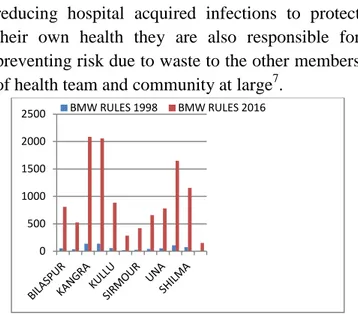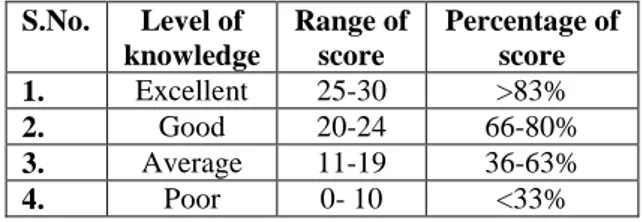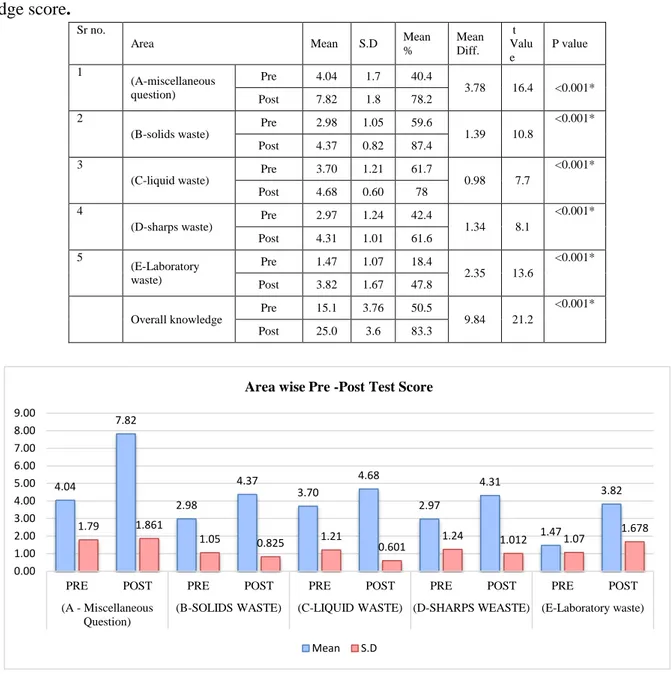Minal Panwar et al JMSCR Volume 07 Issue 11 November 2019 Page 76
A Pre-Experimental Study Assess the Knowledge on Biomedical Waste Management
(BMW) among GNM final year Nursing Students of Selected Colleges at Distt Mandi
(H.P)
Authors
Minal Panwar
1, Nisha Kumari
21
Assistant Professor, Abhilashi College of Nursing, India, 175008 2
Associate Professor, Abhilashi College of Nursing India, 175008
Abstract
Knowledge regarding bio medical waste management plays a vital role in nursing students for their clinical practice.
Aim and Objectives: The study aim to assess the knowledge of bio medical waste management among GNM final year nursing students and to find out the association between knowledge and demographic variables regarding Bio medical waste management.
Methodology: Pre –experimental one group pre-test-post-test design was. A total of 100 students were enrolled into the study by using convenient sampling technique. The structured closed ended questionnaire was used to assess the knowledge
Result: After pre-test majority of nursing students (84%) had Average knowledge regarding bio medical waste management, Poor knowledge (13%), good (3%) and excellent (none). After Post- Test majority of nursing students (57%) had excellent knowledge regarding bio medical waste management, good knowledge (31%), Average (12%) As calculated chi test was use to determine the association between the score levels and selected demographic variables and “t” test value was significant.
Introduction
“YOU SEE THINGS AND SAY, WHY? BUT I SEE THINGS AND SAY WHY NOT”1
Human beings or animals or in the research activities pertaining thereto or in the production or testing of biological and including categories mentioned in Biomedical waste is are any wastes generated during the diagnosis , treatment or immunization of schedule.
In the developing countries, the waste gets dumped in open areas where rag pickers and beggars in value in search of goods, risk their lives by contacting hazardous disease. Many hospitals in the developed countries are recycling or donating the scraps to the developing countries,
for instance at least 50% of the US hospitals send their single use items to the reprocesses who in turn resell them at relatively low prices after sterilizing them.
Need for the Study
Nursing as a profession is now accountable of staff and students nurses for competence and performance. The nurses spend maximum time with patients in the ward than any other member of the health team, increases their exposure and risk to the hazards present in hospital environment, mainly biomedical waste they need to be well equipped with latest information, skills and practice in managing this waste besides
http://jmscr.igmpublication.org/home/ ISSN (e)-2347-176x ISSN (p) 2455-0450
Minal Panwar et al JMSCR Volume 07 Issue 11 November 2019 Page 77 reducing hospital acquired infections to protect
their own health they are also responsible for preventing risk due to waste to the other members of health team and community at large7.
Fig 1: Bar graph showing comparison of number of health care facilities covered under BMW rules 1998 -2016
Statement of Problem
“A Pre-Experimental Study assess The Knowledge on Biomedical Waste Management (BMW) among GNM Final Year Nursing Students Of Selected Colleges At Distt Mandi (H.P)”
Objectives
To assess the knowledge regarding bio medical waste management (BMW) among GNM final year Nursing students at Distt Mandi.(H.P)
To find out the association between knowledge and selected demographic variables Bio-Medical Waste management.
Hypothesis
H1 There will be significant association between
knowledge and demographic variables
H0 There will be not be significant association
between knowledge and demographic variables
Assumption
1) GNM final year Nursing students may have some knowledge regarding BMW 2) Providing booklet will increase the
knowledge of nursing students regarding BMW.
Delimitations
The GNM 3rd year student who are studying in selected nursing colleges and school of Distt Mandi (H.P)
Methodology
Research approach and design: To assess the knowledge regarding biomedical waste management among G.N.M nursing students a Pre- experimental one group pre test-post test design with Quantitative research approach.
Setting of the study: The study was undertaken Nursing colleges at Distt, Mandi H.P.
Population: The population for the study comprised G.N.M Nursing students of selected nursing colleges.
Samples: Samples of the study were G.N.M. Nursing students of the selected colleges of Distt. Mandi H.P.
Sample Size: Sample size were 100.The samples included 40, 35 and 45 students respectively from each college.
Sampling Technique: In the present study the G.N.M. Nursing students were selected by convenient sampling.
Inclusion Criteria The following inclusion criteria are set to select the samples.
G.N.M. final year Nursing students
Students available at the time of data collection
Those who have consented to participate in the study.
Exclusion Criteria Samples excluded in the present study were students,
The study excluded the students those who had already participated in the same type of study.
Those colleges who are not given the permission for data collection.
Description of the Tool
Section-A: The Performa for sample
characteristics was developed together personal data about Nursing Student i.e. age, gender, residence, marital status, religion Education, source of information, college area Clinical area,
0 500 1000 1500 2000
Minal Panwar et al JMSCR Volume 07 Issue 11 November 2019 Page 78 Previous knowledge regarding the Bio medical
waste management.
Section-B: Each correct question was awarded a score of “1”and for every incorrect question a score of “0”was given. Thus, total score on structured knowledge questionnaire ranged from 0-30, maximum possible score was “30”and minimum score was “0”.
S.No. Level of knowledge
Range of score
Percentage of score 1. Excellent 25-30 >83%
2. Good 20-24 66-80%
3. Average 11-19 36-63%
4. Poor 0- 10 <33%
Validityof the Tool
Items were judged by 7 experts for relevance, clarity and appropriateness. Modifications were done in the tool as per expert opinion.
Reliability of the Tool
Reliability was established by split half method.
The steps adopted for development of information booklet were as follows-
Review of Literature
Journals, Books, internet as sources used Opinions and suggestions from guide
The contents covered the following areas- Solid waste Management
Liquid waste management Liquid waste management Laboratory waste management Sharps waste management
Data Collection Procedure
Formal permission for final data collection of the study was obtained from the concerned authorities of various selected colleges from Distt Mandi (H.P). The study was conducted in April, 2019. All Students of GNM final year in selected colleges was taken subsequently by using convenient sampling techniques. Objectives of study were discussed and consent was obtained from participants of the study subjects were
assured about the confidentiality of data. On the day 1, nursing students were instructed to fill the section A selected demographic variables took 10 minutes. Pre –test assessment of knowledge was done on the same day by structured questionnaire. On the same 1st day, after pre-test one booklet each student was provided to them, it took 10 minutes. On the 15thday, 2nd post –test assessment of knowledge of nursing students regarding BMW was done using the same questionnaire and it took around 10 minutes to complete the questionnaire.
Plan for Data Analysis
Data were analyzed as follows: Described demographic chacteristics.
Mean, SD, and mean % were used to describe area wise knowledge scores.
Annova and Z' test used to find out association of knowledge with demographic variables
Results
The demographic characteristics of the respondents revealed that most of the students 95% belongs to 20-21 years old , about gender 100% were females ,99% were residing in hostel and 96%belongs to Hindu religion .Regarding marital status 99% of students were unmarried about education 61% of students completed secondary education and 38% completed other diploma courses . Around 89% of student had clinical practice from govt. hospital where as 11% from private hospital.
Regarding previous knowledge about BMW 90% revealed that they have knowledge about BMW in which 93% of students said that the source of information is through books about the location of student college 54% located in urban and 46% is rural area.
Table 4.1 Shows Range ,Mean, SD, mean, mean diff., t value comparison of pr- test and post- test score of nursing student
"T" Test Mean±S.D. Mean% Range Mean Diff.
"t"
value P value Pre-test
knowledge 15.16±3.67 50.50 7-22
9.840 21.287
* <0.001* Post-test
Minal Panwar et al JMSCR Volume 07 Issue 11 November 2019 Page 79
Table 4.2 Area wise Mean, Standard deviation, mean percentage, mean difference, “t” value of pre-post knowledge score.
Sr no.
Area Mean S.D Mean
%
Mean Diff.
t Valu e
P value
1
(A-miscellaneous question)
Pre 4.04 1.7 40.4
3.78 16.4 <0.001*
Post 7.82 1.8 78.2
2
(B-solids waste)
Pre 2.98 1.05 59.6
1.39 10.8
<0.001*
Post 4.37 0.82 87.4 3
(C-liquid waste)
Pre 3.70 1.21 61.7
0.98 7.7
<0.001*
Post 4.68 0.60 78
4
(D-sharps waste) Pre 2.97 1.24 42.4 1.34 8.1
<0.001*
Post 4.31 1.01 61.6 5
(E-Laboratory waste)
Pre 1.47 1.07 18.4
2.35 13.6
<0.001*
Post 3.82 1.67 47.8
Overall knowledge
Pre 15.1 3.76 50.5
9.84 21.2
<0.001*
Post 25.0 3.6 83.3
Figure no. 4.1 Bar graph showed score of the nursing students mean and SD value according to the area
Association between knowledge scores and selected demographic variables
that the association between the level of score and socio demographic variable. Based on the 2nd objectives used to Chi-square test used to associate the level of knowledge and selected demographic variables. The Chi-square value shows that there is significance association between the score level and demographic variables (Religion, In which hospital going to Clinical Practice, Previous Knowledge regarding Bio Medical Waste. Source of Information). There is no significance association between the level of
scores and other demographic variables other variables. The calculated chi-square values were less than the table value at the 0.05 level of significance
Recommendations
1) A replication of the present study can be conducted with large subjects.
2) A study can be done by observing the practice of hospital waste disposal among health care provider
3) A similar study can be conducted in various health care setting.
4.04
7.82
2.98
4.37
3.70
4.68
2.97
4.31
1.47
3.82
1.79 1.861
1.05 0.825 1.21
0.601 1.24 1.012 1.07
1.678
0.00 1.00 2.00 3.00 4.00 5.00 6.00 7.00 8.00 9.00
PRE POST PRE POST PRE POST PRE POST PRE POST
(A - Miscellaneous Question)
(B-SOLIDS WASTE) (C-LIQUID WASTE) (D-SHARPS WEASTE) (E-Laboratory waste)
Area wise Pre -Post Test Score
Minal Panwar et al JMSCR Volume 07 Issue 11 November 2019 Page 80 4) A comparative study can be done between
private and public health care centre.
References
1. Mrs Anita miller: a study to assess the effectiveness of strudured teaching program on BMW management among staff nurses in selected hospital at Bangulare .
2. Essay on mananagement of BMW in hospital Article shared by NilayMacwan 3. Dr. JayalkshmiL.S VijayammaAjmera , a
study to aesses the knowledge regarding BMW management among Bsc Student of selected nursing collage udhaipur vol. 5 ISSUE 4 April 2016.
4. Mansi S center for research in urban affairs Institute for social and economic change Ngarabhoui . P.O Bangalure India.
5. Hppcb.nic .in / BMW 2016 pdf.
6. Shakharkar B.M. Principals of Hospital Administration 1st Ed. New Delhi: Jaypee Publishers 1998.
7. Khairun nessa MA Quaiyeem Barkat-e-Khuda Waste management in Health Care Facilities : A Review 2001.
8. Indian Nursing Year Book: Implementation of various technologies for treatment and disposal of Bio-medical waste New Delhi: 2000-2001.
9. Central Pollution Control Board Manual on Hospital Waste Management New Delhi:
10.Ministry of Environment and Forest: 1999.
11.Tanuja shigh , Tika R .Ghimire awareness of bio medical waste management in dental students in different Dental college Nepal 2018.
12.Dhasarathi kumar a study to knowledge level on bio medical waste management among the nurses in Tamilnadu volume 3 2018
13.MrAlin Thomas Cherian effective ness of structured teaching programme on knowledge regarding Bio medical waste management Bombay hospital college of Nursing, Indor , India 2017
14.Amita, Anjana, Ankita Dhiman a study to assess the knowledge and practices regarding bio medical waste management staff nurses at Deen Dayal Upadhyaya Z.H Shimla, (H.P)2017 ;3(8) 704 – 708
15.Suganya Panneerselvam knowledge on the Bio medical waste management among Nurses working in Hospital at Madurai 2016 ISSN 2249- 9571
16.Dr Monika Bhardwaj*1Dr Rajiv Joshi awareness on bio medical waste management among under graduate medical students of Panjab 2016
17.Ananthachari K.P Divya C.V a study to assess the knowledge on bio medical waste management among heath care worker of Malabar Medical College teaching hospital, kerala, India 2016 sep ; 3 (9): 2409- 2413
18.Merlin Mary James ,Macheri Naseem, Chhugani Manju a study to assess the knowledge of Nursing and MBBS Student regarding BMW management and to, develop an information Booklet on BMW management in a selected university of new Delhi CHN vol/no 2 2016
19.Shamim Haider , Sneha Kumari a study on knowledge and practice regarding bio medical waste management among staff nurses and nursing student of Rajendra Institute of medical Science , Ranchi India J comm Health. 2015; 27, 1: 135- 138 vol 27 /Issue 01.
Minal Panwar et al JMSCR Volume 07 Issue 11 November 2019 Page 81 evolution of medical and dental sciences
2015; vol. 4Issue 50. /2015/1253.
21.Dr Bhishakhi Paria, Dr Debasis Das, Knowledge and Practice Regarding BMW waste in different levels of Government Health care Facilities in waste Bengal e ISSN; 2279 -0853 p-ISSN 2279 -0861 22.S. Sangeetha Balamurugan Priyadarisini
S.P A descriptive study on knowledge Regarding BMW management among health care personnel in a tertiary care Hospital , Salem, Tamil Nadu ,National Journal Research in community Medicine . Vol.3 Issue 2 2014.
23.Ms .J. Mano Ranjini a study to assess the knowledge BMW disposal among the Group D worker in sri Ramakrishna Hospital , 2014 ; 1(4): 465 -470.
24.Violet N. Pinto, Deepa H. Velanker, Madhavi J. Manker, Acomparative study of knowledge and attiudes regarding BMW management with a preliminary intervention in an cademic hospital .Int J Med published Health 2014;4:91-5.


